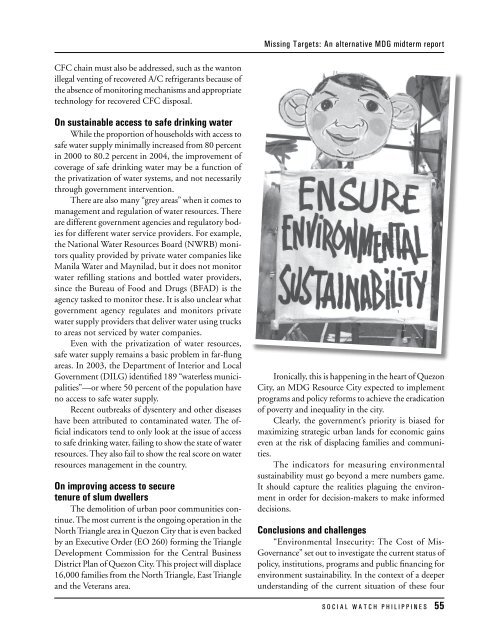one big file - Social Watch
one big file - Social Watch
one big file - Social Watch
Create successful ePaper yourself
Turn your PDF publications into a flip-book with our unique Google optimized e-Paper software.
Missing Targets: An alternative MDG midterm report<br />
CFC chain must also be addressed, such as the wanton<br />
illegal venting of recovered A/C refrigerants because of<br />
the absence of monitoring mechanisms and appropriate<br />
technology for recovered CFC disposal.<br />
On sustainable access to safe drinking water<br />
While the proportion of households with access to<br />
safe water supply minimally increased from 80 percent<br />
in 2000 to 80.2 percent in 2004, the improvement of<br />
coverage of safe drinking water may be a function of<br />
the privatization of water systems, and not necessarily<br />
through government intervention.<br />
There are also many “grey areas” when it comes to<br />
management and regulation of water resources. There<br />
are different government agencies and regulatory bodies<br />
for different water service providers. For example,<br />
the National Water Resources Board (NWRB) monitors<br />
quality provided by private water companies like<br />
Manila Water and Maynilad, but it does not monitor<br />
water refilling stations and bottled water providers,<br />
since the Bureau of Food and Drugs (BFAD) is the<br />
agency tasked to monitor these. It is also unclear what<br />
government agency regulates and monitors private<br />
water supply providers that deliver water using trucks<br />
to areas not serviced by water companies.<br />
Even with the privatization of water resources,<br />
safe water supply remains a basic problem in far-flung<br />
areas. In 2003, the Department of Interior and Local<br />
Government (DILG) identified 189 “waterless municipalities”—or<br />
where 50 percent of the population have<br />
no access to safe water supply.<br />
Recent outbreaks of dysentery and other diseases<br />
have been attributed to contaminated water. The official<br />
indicators tend to only look at the issue of access<br />
to safe drinking water, failing to show the state of water<br />
resources. They also fail to show the real score on water<br />
resources management in the country.<br />
On improving access to secure<br />
tenure of slum dwellers<br />
The demolition of urban poor communities continue.<br />
The most current is the ongoing operation in the<br />
North Triangle area in Quezon City that is even backed<br />
by an Executive Order (EO 260) forming the Triangle<br />
Development Commission for the Central Business<br />
District Plan of Quezon City. This project will displace<br />
16,000 families from the North Triangle, East Triangle<br />
and the Veterans area.<br />
Ironically, this is happening in the heart of Quezon<br />
City, an MDG Resource City expected to implement<br />
programs and policy reforms to achieve the eradication<br />
of poverty and inequality in the city.<br />
Clearly, the government’s priority is biased for<br />
maximizing strategic urban lands for economic gains<br />
even at the risk of displacing families and communities.<br />
The indicators for measuring environmental<br />
sustainability must go beyond a mere numbers game.<br />
It should capture the realities plaguing the environment<br />
in order for decision-makers to make informed<br />
decisions.<br />
Conclusions and challenges<br />
“Environmental Insecurity: The Cost of Mis-<br />
Governance” set out to investigate the current status of<br />
policy, institutions, programs and public financing for<br />
environment sustainability. In the context of a deeper<br />
understanding of the current situation of these four<br />
S O C I A L W A T C H P H I L I P P I N E S 55

















